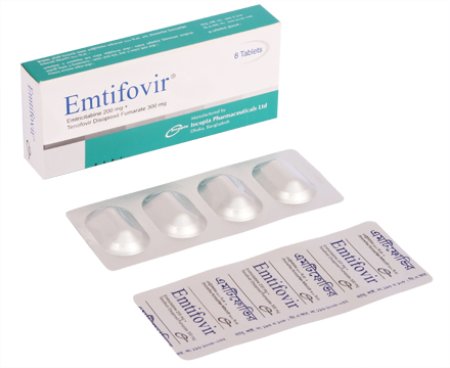
Type:8 Tablets
Generic Name:Emtricitabine + Tenofovir disoproxil
Manufacturer:Incepta Pharmaceuticals Ltd.
Price:৳800.00
HIV-1 infection, Pre-exposure Prophylaxis HIV-1 infection
May be taken with or without food. Take consistently either always w/ or always w/o food.
Oral HIV-1 infection, Pre-exposure Prophylaxis in combination with other antiretroviral agents Adult: 1 tablet once daily. Hepatic impairment Dose adjustment not necessary in moderate-to-severe hepatic impairment
Renal impairment: Patient on haemodialysis: Not recommended. CrCl (ml/min) 30-49 1 tablet every 48 hr. <30 Not recommended.
Lactation. Not to be used for treatment of chronic hepatitis B virus (HBV) infection.
Tenofovir disoproxil fumarate, a diester prodrug of tenofovir, is rapidly converted to tenofovir, an acyclic nucleoside phosphonate (nucleotide) analogue of adenosine 5'-monophosphate while emtricitabine is a synthetic nucleoside analogue of cytidine. Both emtricitabine and tenofovir inhibit HIV-1 reverse transcriptase, resulting in DNA chain termination.
Lactic Acidosis/Severe Hepatomegaly With Steatosis. Liver impairment. Renal impairment; avoid in CrCl <30ml/min and in patients on dialysis. Pregnancy. Not to be used with other emtricitabine, tenofovir disoproxil fumarate or other cytidine analogues (e.g. lamivudine and zalcitabine) preparations. Increased risk for severe and potentially fatal hepatic adverse reactions in patients with HIV and hepatitis B or C virus co-infection treated with antiretroviral agents. If combination drug is discontinued in patients co-infected with HIV and HBV, monitor hepatic function for several months for acute exacerbation of hepatitis. Discontinue therapy if there is a rapid rise in aminotransferase concentrations, progressive hepatomegaly or steatosis, metabolic or lactic acidosis of unknown cause. Test for presence of chronic HBV before initiating therapy. Check CrCl before initiation of therapy and monitor renal function (CrCl and serum phosphate) every 4 wkly during the 1st year and then every 3 mthly (more frequently in patients at risk for renal impairment). Bone monitoring needed for patient with history of pathologic bone fracture or at risk of osteopenia. Monitor child exposed in utero to combination drug for possible mitochondrial dysfunction. Lactation: excretion in milk unknown/not recommended
>10% Diarrhea,Nausea,Fatigue,Headache,Dizziness,Depression,Insomnia,Abnormal dreams,Rash 1-10% Note: includes adverse effects grade 2-4 Diarrhea (9%),Nausea (9%),Fatigue (9%),Depression (9%),Sinusitis (8%),URI infections (8%),Dizziness (8%),Rash event (7%),Headache (6%),Nasopharyngitis (5%),Insomnia (5%),Vomiting (2%) Potentially Fatal: Lactic acidosis and severe hepatomegaly with steatosis.
Pregnancy Data on the use during pregnancy from observational studies have shown no increased risk of major birth defects Available data from the Antiretroviral Regnancy Registry (APR) show no increase in the overall risk of major birth defects with first trimester exposure for emtricitabine (2.3%) or tenofovir DF (2.1%) compared with the background rate for major birth defects of 2.7% Pregnant women with HIV infection should continue antiretroviral drugs according to current guidelines during pregnancy to decrease maternal-fetal viral transmission (https://aidsinfo.nih.gov) Lactation Emtricitabine and tenofovir have been shown to be present in human breast milk HIV-1 infected women The CDC recommend that HIV-1 infected mothers not breastfeed their infants to avoid risking postnatal transmission of HIV-1 Because of the potential for HIV transmission (in HIV-negative infants); developing viral resistance (in HIV-positive infants); and adverse reactions in a breastfed infant similar to those seen in adults Instruct mothers not to breastfeed Women taking PrEP In HIV-uninfected women, consider the developmental and health benefits of breastfeeding and the mother’s clinical need of drug therapy for HIV-1 PrEP along with any potential adverse effects on the breastfed child from drug therapy and the risk of HIV-1 acquisition due to nonadherence and subsequent mother to child transmission Women should not breastfeed if acute HIV-1 infection is suspected because of the risk of HIV-1 transmission to the infant
Decreased atazanavir concentration with tenofovir unless also co-administered with ritonavir. Increased serum concentration of both tenofovir and emtricitabine or co-administered drug if taken with drugs that are eliminated by active tubular secretion. Potentially Fatal: Increased risk of renal impairment with recent or concurrent use of nephrotoxic agents (e.g. aminoglycosides, amphotericin B, foscarnet, ganciclovir, pentamidine, vancomycin, cidofovir or interleukin-2); monitor renal function wkly if unavoidable. Increased didanosine levels and thereby increasing risk of pancreatitis and peripheral neuropathy, with a high treatment failure rate with concurrent use; avoid concurrent use. Do not use emtricitabine with lamivudine due to similar resistance profile. Increased risk of lactic acidosis with ?-interferon.